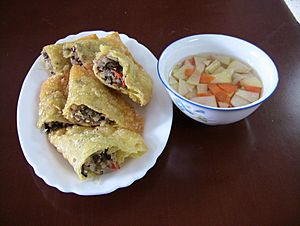Bánh gối facts for kids
 |
|
| Alternative names | Bánh quai vạc |
|---|---|
| Type | dumpling |
| Place of origin | Vietnam |
Bánh gối (say "Ban Goy") is a super yummy Vietnamese dumpling. It's also called Bánh xếp or Bánh quai vạc. You'll often find it sold as street food all over Vietnam. Think of it like a tasty, crispy pillow!
What's Inside Bánh Gối?
Bánh gối usually has a savory filling. This filling often includes seasoned ground meat, mushrooms, and thin vermicelli noodles. You might also find diced vegetables like carrots, kohlrabi, and jicama. Sometimes, people add boiled egg slices or Chinese sausage.
All these yummy ingredients are wrapped in a thin piece of dough. Then, the whole thing is deep-fried until it's golden and crispy.
There's also a sweet version of bánh gối! This one is filled with mung bean paste, sugar, and shredded coconut.
How Bánh Gối Came to Be
Many people believe that bánh gối was inspired by other famous pastries from around the world. These might include the British Cornish pasty or the Spanish empanadas. Another similar dish is the pastel.
In the 1500s, Portuguese traders and explorers were some of the first Europeans to visit Asia. They set up trading posts in places like Goa, India, Malacca, and Macau. This travel and trade helped different food ideas spread across Asia. Over time, pastries like the pasty became popular snacks in many Asian countries.
Bánh gối itself is thought to have come from a Chinese dish. It's similar to the deep-fried jiaozi (a type of Chinese dumpling) from Guangdong. This dish was brought to Vietnam before 1954.

